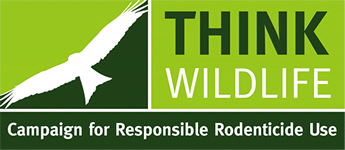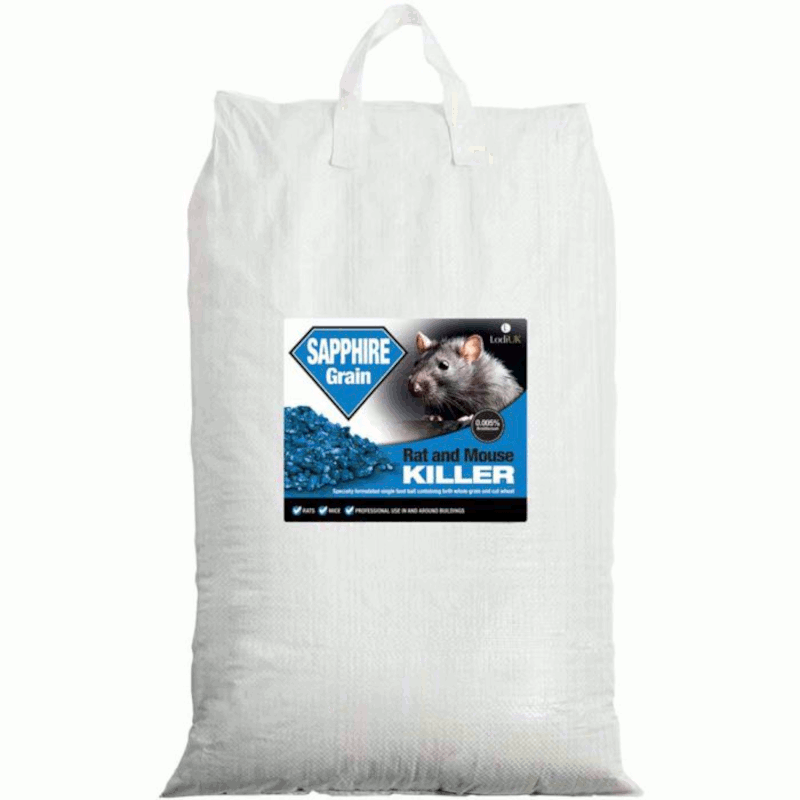Sapphire Grain 10KG Wholegrain Brodifacoum
WG080 - Sapphire Grain 10KG Wholegrain Brodifacoum Professional use only - Sign into your A/c for price |
- Contains Brodifacoum 0.005% /li>
- A specially formulated bait combining the attraction of cut wheat and whole wheat for both rats and mice.
- Sapphire grain is a single feed bait approved for use in and around buildings.
- Highly palatable, apple flavoured bait, with excellent efficacy
User category: For professional use only
Field of use: Indoor and outdoor use (around building only)
Application method: In bait stations or other covering
Target organisms:
Mus musculus House mouse, Rattus norvegicus Brown rat; Rattus rattus Roof rat, House rat
Resistance information:
The resistance status of the target population should be taken into account when considering the choice of rodenticide to be used. In those areas where evidence of resistance to specific active ingredients is suspected, avoid their use. To control the spreading of resistance, it is advisable to alternate baits containing different anticoagulant active ingredients.
Precautionary statements:
Keep out of reach of children.
Read label before use.
Keep/store away from food, drink and animal feeds.
Do not get on skin.
Do not eat, drink or smoke when using this product.
Avoid release to the environment.
Wear protective gloves
IF SWALLOWED: Immediately call a poison centre or doctor/physician.
Store locked up in a closed container.
Dispose of contents/container in accordance with national regulations.
Particulars of likely direct or indirect effects, first aid instructions and emergency measures to protect the environment.
Oral: In case of ingestion or if swallowed seek medical advice immediately.
Eyes: In case of contact with eyes, remove contact lenses if present and rinse the eye slowly and gently with water for 15-20 minutes. Seek medical advice immediately.
Dermal: In case of contact with skin, wash with soap and water. Remove and launder any contaminated clothing.
General: In case of accident or if you feel unwell, seek medical advice immediately (show the label where possible).
Brodifacoum is an anticoagulant which may produce bleeding; this may be delayed for several days after exposure. If there is no active bleeding the INR (prothrombin time) should be measured on presentation and 48-72 hours after exposure. If the INR is greater than 4, administer Vitamin K1 (phytomenadione) 5-10 mg by slow intravenous injection (100 μg/kg body weight for a child). Treatment with phytomenadione (orally or intravenously) may be required for several weeks. The advice of the National Poisons Information Service (http://www.npis.org/) should be sought particularly if active bleeding occurs.
Conditions of storage:
Keep in a cool, dry, well ventilated area.
Store away from light.

As a distributor of many forms of professional and amateur use rodenticide PestFix actively supports and promotes the Campaign for Responsible Rodenticide Use to its customer base. PestFix is a registered CRRU supporter.
The CRRU aims to protect wildlife while promoting and providing effective rodent control through the responsible use of rodenticides.
For further details on CRRU visit www.thinkwildlife.org
We ask that ALL of our customers, whether you are an amateur user or professional user to follow the CRRU Code at ALL times
Application rate(s) and frequency:
For rats: secure 45-60g of bait in covered, tamper resistant baiting stations spaced 10m apart (5m apart in areas of high infestation) in areas where rats are active. Regularly check bait consumption and replace consumed or spoilt bait.
For mice: secure 10-25g of bait, in covered, tamper resistant baiting stations spaced 5m apart (2m apart in high infestation areas) in areas where mice are active. Regularly check bait consumption and replace consumed or spoilt bait.
Instructions for use:
The product must be applied by professional users only when appropriate chemical resistant gloves (EN 374) are used. Baits must be securely deposited in a way so as to minimize the risk of consumption by other animals or children.
Prevent access to bait by children, birds and non-target animals (particularly dogs, cats, pigs and poultry). Where possible, secure baits so that they cannot be dragged away.
Unless under the supervision of a pest control operator or other competent person, do not use anticoagulant rodenticides as permanent baits. In most cases, anticoagulant bait should have achieved control within 35 days. Should activity continue beyond this time, the likely cause should be determined.
Search for and remove dead rodents at frequent intervals during treatment (unless used in sewers), at least as often as when baits are checked and/or replenished. Daily inspection may be required in some circumstances.
Dispose of dead rodents in accordance with local requirements. In the UK poisoned rodents may be disposed of by the waste producer at an incinerator or landfill permitted to accept that type of waste, or collected by a registered waste carrier and taken for disposal at a suitably permitted site.
For further information on disposal contact the Environment Agency (http://www.environment-agency.gov.uk) or SEPA (http://www.sepa.org.uk).
Public area use:
For products to be used in public areas the following safety precaution shall be carried on the label, packaging or accompanying leaflet: when the product is being used in public areas, the areas treated must be marked during the treatment period and a notice explaining the risk of primary or secondary poisoning by the anticoagulant as well as indicating the first measures to be taken in case of poisoning must be made available alongside the baits. When tamper resistant bait stations are used, they should be clearly marked to show that they contain rodenticides and that they should not be disturbed.
Instruction for safe disposal of the product and its packaging:
Remove all baits after treatment and dispose of them in accordance with local requirements. Dead rodents and bait found outside bait stations should be disposed of using protective gloves. In the UK: For information on disposal contact the Environment Agency (http://www.environment-agency.gov.uk) or SEPA (http://www.sepa.org.uk).














